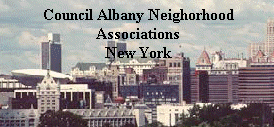The Pastures, touted as the first
neighborhood to be settled beyond Albany's original stockade, almost went
the way of other historic areas in the city, but it was saved and listed
on the National Register of Historic Places in 1972. Today, the
neighborhood of brick, Federal-style houses is home to a diverse
population.
"It was the Preservation Act of 1966 and a new attitude about old
buildings that made this neighborhood a rehab project rather than
demolition," says Tony Opalka, a local historian. "The Pastures
neighborhood has the best group of two- and three-story Federal-style
buildings in the city. It's textbook architecture. There you'll see
typical Federal features from shallow-pitched to flat roofs to dormers.
There's still a lot of historical material in many of the the interiors as
well. Most of the buildings in this enclave date prior to 1850."
Opalka says most of the houses are of affordable brick construction
because of the particular audience they were built for: the middle class,
including merchants, brewers and ship owners.
The Pastures takes its name from the land it is situated on, which was
pasture land in the 1600s. Today, it's bounded by Madison Avenue to the
north, South Ferry Street on the south, Dongon Avenue to the east and
South Pearl Street to the west.
In the early 20th century, the Pastures was the location of several of
the city's great jazz bars and one of Albany's red-light districts.
As the fabric of cities across the country changed between the late
1940s and early 1970s and people migrated to the suburbs, the Pastures
became a forgotten neighborhood of derelict structures with leaking roofs
and broken windows.
In the early 1980s, Albany's Urban Renewal Agency coordinated a $10
million renovation of the 26-acre neighborhood with both federal and
private funding.
The result was 101 rental units, 150 subsidized rental units and 67
condominiums and several privately owned townhouses. Many of the buildings
incorporated commercial spaces still in use.
There are also pocket lots, one a playground with swings, and several
off-street parking-permit lots for members of the Pastures Homeowners
Association.
Although the neighborhood is old, its utilities are up-to-date and, on
some streets, underground. In addition, new walkways of concrete and brick
have replaced older, crumpled versions.
Revitalization continues in the neighborhood, which also features
low-income Section 8 program housing, says Lori Harris, Albany's
commissioner of development and planning.
"The Pastures Townhouses, which have sat vacant for almost the
last 15 years, is now completely renovated and fully leased," said
Harris. "There's a mix of incomes and occupations that we strive for
in our city neighborhoods. The Albany Housing Authority is located on the
perimeter of the neighborhood, which is fueling owner-occupied businesses
in and around the neighborhood."
Among the new businesses are a Laundromat, 99 Cent store and a fish
market/fish fry store. Around the corner on Madison Avenue, Angel's Bed
and Breakfast is located in the historic Governor Joseph Yates House. The
B&B offers Southern-style cooking daily and jazz on Friday evenings.
"I started renting there four years ago, when I moved up from
Queens," says Larry Brady, a stockbroker with Wachovia Securities in
Albany and interim president of the Pastures Homeowners Association.
"About three years ago, I bought my first condominium and three
others since then. I like the historic nature of the neighborhood. It sort
of has the same feeling as Greenwich Village, where I also lived for a
while.
"I like the fact that I can walk to work," adds Brady.
"I also like to be able to walk to the Pepsi Arena and
restaurants."
Addressing the question of crime in the neighborhood, Brady says,
"It is a city and downtown. There are going to be intermittent
situations. We're trying to get a neighborhood watch association under way
to deter this type of potential."
Detective James Miller, public information officer for Albany's
Department of Public Safety, says a beat officer patrols the neighborhood.
"There is nothing in recent memory that stands out as a regular
occurrence or major crime in the Pastures neighborhood," says Miller.
"Most of the problems are always perceptions."
At a glance:
Approximate housing values: Apartment rentals $350 to $750;
condominiums $25,000 to $35,000; single-family $80,000 to $120,000.
Schools: Children attend Giffen Elementary for prekindergarten to grade
6; Hackett Middle School for grades 6-8; and Albany High School for grades
9-12.
Taxes: Residents pay $14.75 per $1,000 of the full-assessed value for
city and county and $23 per $1,000 for school. Taxes on a $110,000 house
would be approximately $4,153.
Frances Ingraham Heins can be reached at 454-5502 or by e-mail at
fingraham@timesunion.com.
